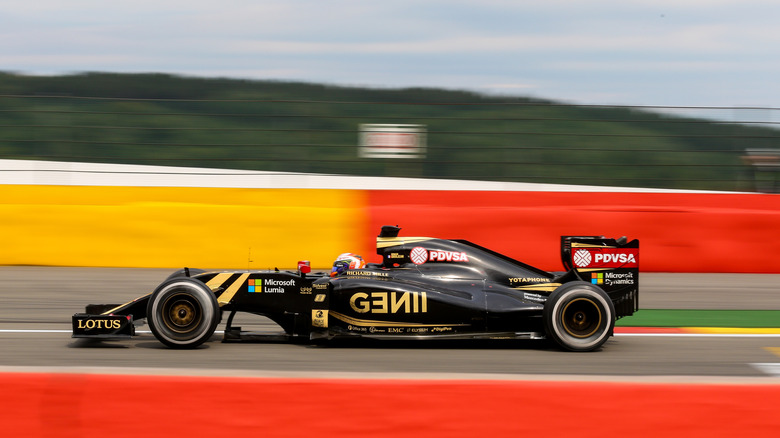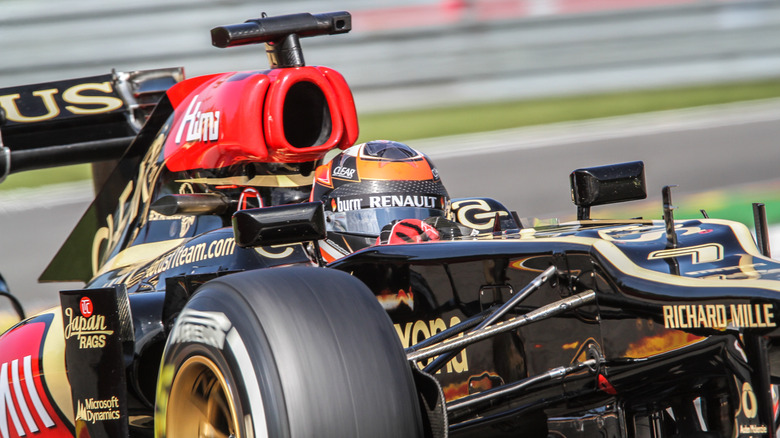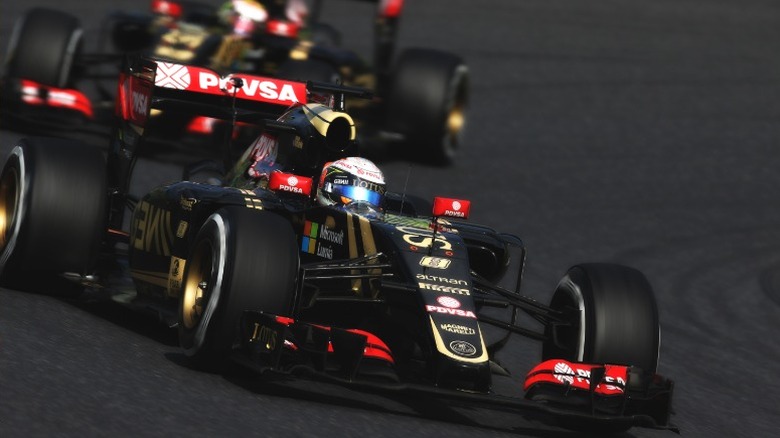What Happened To The Lotus F1 Team?
Lotus is one of the most successful and celebrated brands to have ever competed within the world of Formula One. Despite no longer competing, it's remembered for having built some of the fastest F1 cars of all time. One of the facts that new F1 fans may not know is that Lotus racked up 79 victories and seven constructors' titles between 1958 and 1994. Lotus disappeared from the upper echelons of motorsport for some time after that, only to return in 2011, fresh-faced and looking to recapture some of its previous successes. They say that fortune favors the bold, but that wasn't the case here, as the revived Lotus F1 team only lasted four short years before succumbing to huge debts that effectively crippled the team and its future chances.
The demise of the Lotus F1 team was down to a multitude of factors, including extortionately expensive driver contracts, unpaid tax bills, and spiraling management costs. Here, we'll dive into how the pressures that pulled the iconic F1 team apart and see what happened to it after its troubled 2015 season.
Lotus F1's contact incentives backfired
Lotus, then known as Lotus-Renault, had a poor 2011 season, finishing 10th in the constructors' championship and failing to collect any championship points. To net some better results, Lotus F1 signed ex-world champion Kimi Räikkönen, arguably one of the best F1 drivers of all time, for the 2012 and 2013 seasons. On paper, this seemed like a genius move. However, a clause included in Räikkönen's contract would soon result in Lotus facing some serious bills.
The team promised Räikkönen €50,000 for every point scored across his two-year contract. The Finn scored 390 points throughout the 2012 and 2013 seasons, which meant that Lotus F1 had to pay €19.5 million in bonuses to Räikkönen, which allegedly nearly bankrupted the team. However, the points Lotus gained from Räikkönen and teammate Romain Grosjean helped it secure fourth place in the constructors' championship in 2012 and 2013. Hopes were high at Lotus HQ, but the following two seasons would see all this success begin to fall apart.
Renault purchased the Lotus F1 team in 2015
The 2014 season introduced new regulations, alongside management and driver changes for the team. Kimi Räikkönen returned to Ferrari, while failed sponsor deals meant that Lotus had to settle for subpar drivers as a result. Poor results followed throughout the entire season, and the team had to settle for eighth in the constructors' championship. By the 2015 season, things were really starting to look uncertain for Lotus, with Pirelli even refusing to hand tires over at the Hungarian Grand Prix due to unpaid bills. This was only the tip of the iceberg, though. Lotus had more than just race-related bills to pay, as it also owed significant sums to the British government in unpaid taxes. As the year began to close, Lotus was desperate for an answer to its spiraling financial woes.
As the year came to a close, it was confirmed that Renault would buy Lotus out and return to F1 under its name. This resulted in the British government stopping insolvency proceedings, with Renault now taking responsibility for the tax losses. In total, Lotus managed a £57 million loss in 2015 alone, which was enough to force the once-legendary team to close its doors for good after negotiating and accepting a £1 buyout from Renault.


